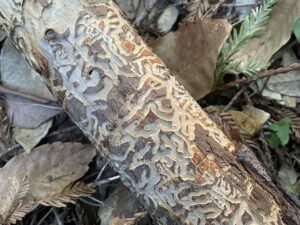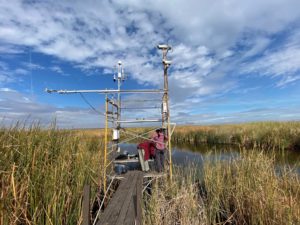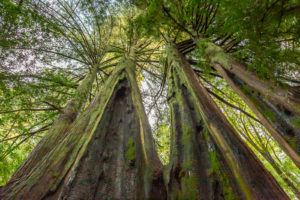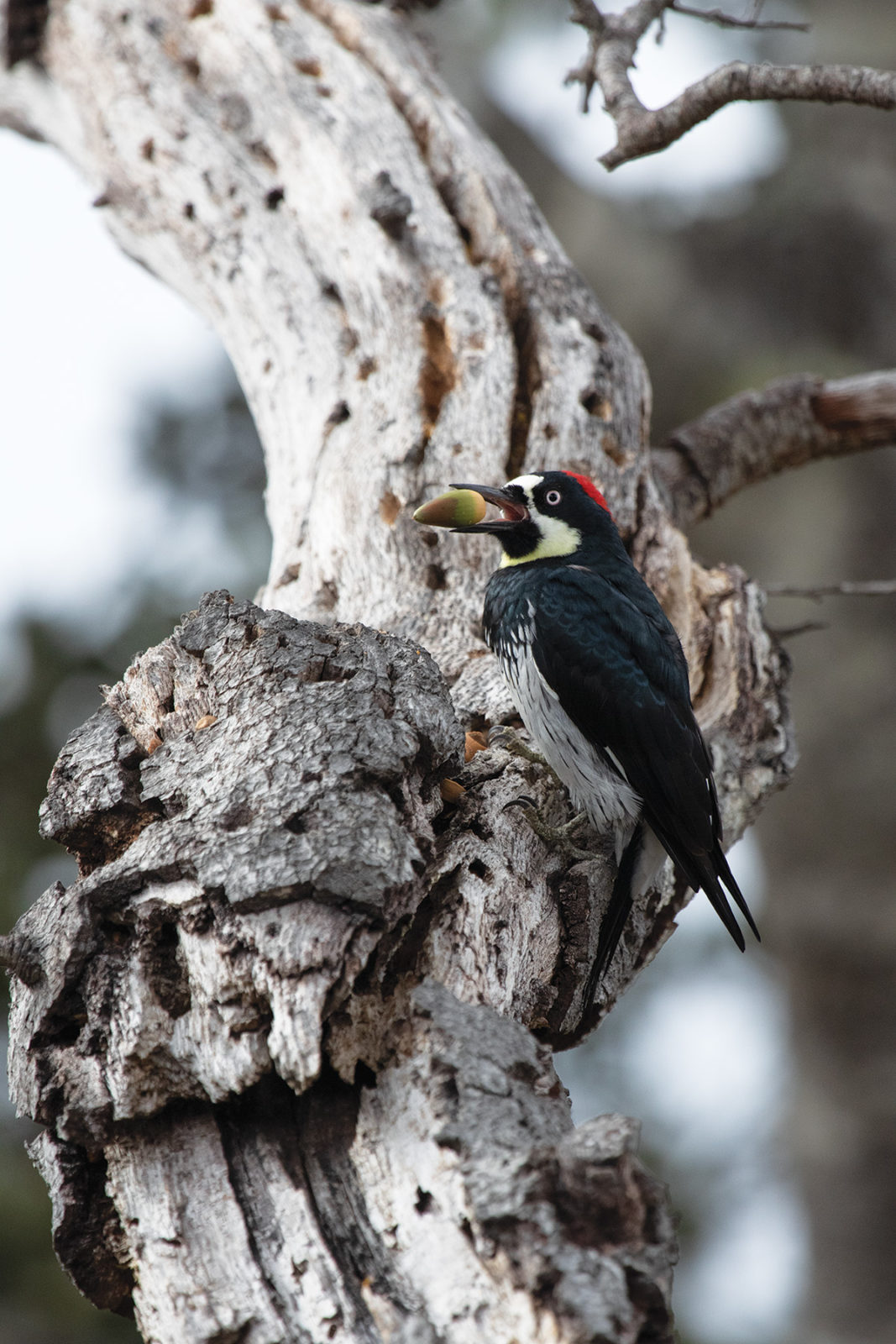
Fall 1983 brought hard times to acorn woodpeckers in upper Carmel Valley. For the first year since I’d begun studying these group-living birds, as a UC Berkeley graduate student a decade earlier, none of the oaks at our study site bore more than a pathetically poor acorn crop. Twenty-four of the 34 acorn woodpecker groups we were following—over 120 painstakingly banded birds—abandoned their territories, leaving a small fraction of individuals to eke out a living over the winter. It was apparently the end of the study, and possibly of my hopes for a degree. But then, the following spring, nearly all the abandoned territories—each roughly seven to 20 acres of oak woodland with one or more granaries in which the birds store acorns—were recolonized, mostly by former group members. We knew why they’d left: there were no acorns to store or eat during the cold, rainy winter months. But where had they gone? How far had they flown to find acorns to eat? And why had the acorn crop failed to begin with?
These questions eventually led me to a second career, of studying acorn production by oaks, the dominant tree genus throughout much of low- and mid-elevation, temperate California. It was well known that the size of the acorn crop varies dramatically from year to year and that this variability is critically important to the demography of many species, including the acorn woodpeckers. Little was known about what factors determine whether it’s a good or a bad acorn year, however. And what about the birds that came back after abandoning their territories? We had no idea where they spent the winter, but presumably it wasn’t far away. Did that mean trees close by had produced a good crop of acorns?
Such issues inhabit the world of “masting” or “mast-fruiting”—the production of highly variable and synchronized seed crops from one year to the next. And it turned out to be a big world: masting species include not only oaks but many conifers and a variety of other taxa, mostly in temperate and boreal regions of the globe (although there is as yet relatively little data from the tropics). Masting has been of interest to foresters for over 200 years and to farmers and others dependent on the productivity of the natural world for millennia. Early references date to the Middle Ages, when a common activity during the late fall was to use sticks and clubs to knock down acorns as food for swine when the crop was good. Here in California, acorns were a critically important food for Indigenous peoples. (Acorn eating was described by one well-known anthropologist as “the most characteristic feature of the domestic economy of the California Indians.”) Interestingly, many of the scientists studying masting in the early 20th century were zoologists whose main interest was the effect of variable seed production on animal populations. For example, masting by boreal conifers such as pines and spruce can result in avian population “eruptions” during which various seed-eating bird species are found far south of their normal winter ranges. I was, as it happened, one of a long line of ornithologists whose focus on avian population ecology led them to masting behavior.
To better understand the interactions between acorns and acorn woodpeckers, two graduate-school colleagues—Ron Mumme and Bill Carmen—and I started surveying acorn production at Hastings Natural History Reservation in the Santa Lucia Mountains, near Carmel Valley in Monterey County. Hastings, a field station run by the Museum of Vertebrate Zoology at UC Berkeley, harbors a thriving population of acorn woodpeckers living in a diverse oak woodland with a mix of up to five species of oaks—valley, blue, coast live, canyon live, and California black. A few years later, at the urging of another colleague, Jean Knops, we expanded the project to encompass over 1,000 trees at 25 sites spread across California, including an additional three species of oaks: interior live, Oregon, and Engelmann, and the acorn-producing tanbark oak. Thus was born what we now modestly call the California Acorn Survey.
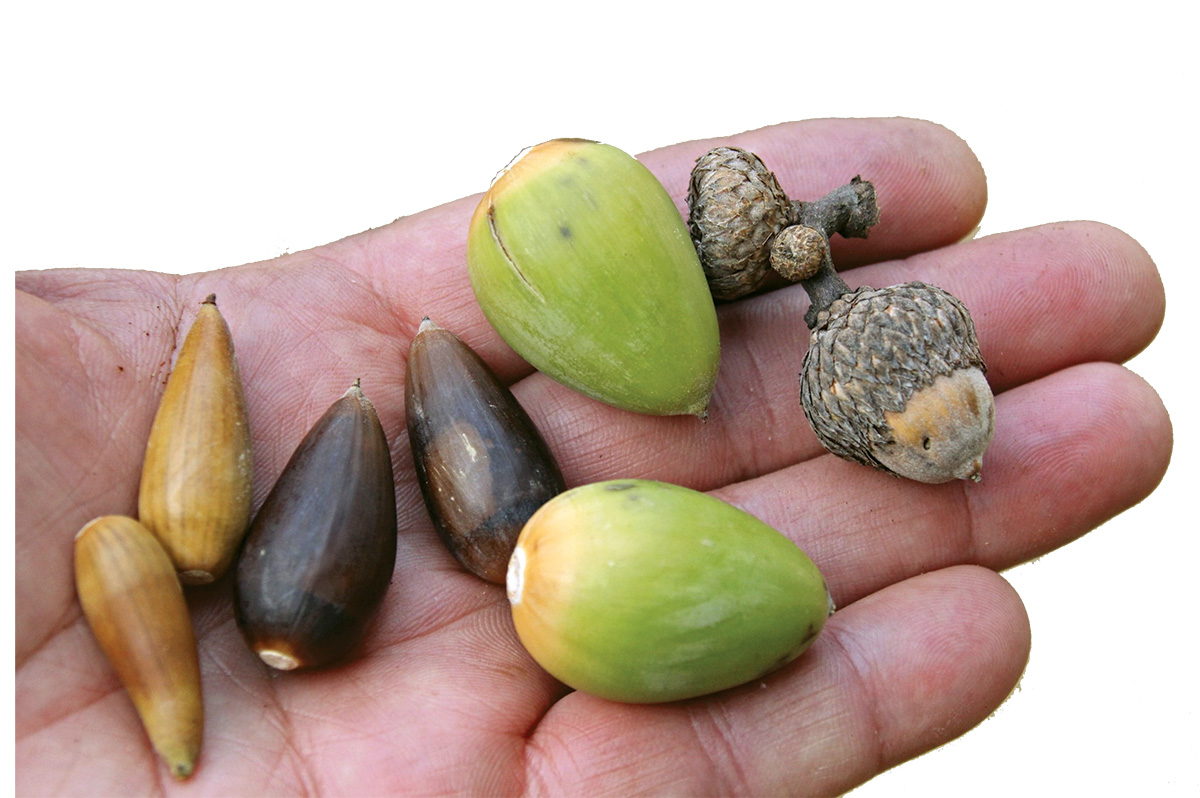
Quantifying acorn production across California is not an easy proposition: this is a big state with a lot of oaks. Oak woodlands cover approximately 8.8 million acres of California; at a conservative average of 50 trees per acre, this verges on half a billion trees. Traditionally, seed traps are used, but traps are time-consuming to set up and difficult to maintain, and we needed a more efficient method to gather data on the scale we envisioned. We settled on visual surveys, a technique pioneered by the California Department of Fish and Game in the 1970s. Using binoculars, two of us visit marked trees in September, before acorns have begun to drop, and count as many acorns as we can on tagged trees for 15 seconds each. Visual surveys only require a minute or two per tree, making it possible to survey enough individuals—usually 10 to 25 trees of each species at a site—to yield good estimates of the overall size of the acorn crop.
Before we started the California Acorn Survey, I’d assumed there were two types of years: “mast” years when lots of acorns are produced and “bust” years when few or no acorns are produced. This turns out not to be the case. Consider valley oaks, one of the widespread species common in the Bay Area and throughout the foothills ringing the Central Valley (as well as, historically, much of the Central Valley itself). Overall, acorn production varies considerably from year to year (Figure 1), but most often it is pretty low—in 23 of 42 years (55 percent), crops were less than 25 percent of the largest acorn crop we recorded. Meanwhile, “mast” years were rare—only three years (7 percent) since 1980 yielded an acorn crop that was 75 percent or more of the maximum crop. Sixteen years (38 percent) were intermediate, falling between 25 and 75 percent of the maximum crop recorded.
So masting is not an all-or-none phenomenon. It can, however, seem like it. California scrub-jays, acorn woodpeckers, band-tailed pigeons, mule deer, squirrels, mice, and (in some areas) black bears eagerly feed on acorns, doing a thorough job of eating nearly all those available very quickly in most years, often before acorns even drop from the trees. In contrast, in mast years, acorn predators can only harvest a small fraction of the crop, leaving many acorns to drop or be dispersed (often by those scrub-jays) and potentially survive. This interaction leads directly to the idea of “predator satiation,” which is generally considered one of the key, if not the key, evolutionary factors selecting for masting behavior. Basically, if the population of trees always produced the same number of acorns, predator populations would eventually match, and consume, the entire acorn crop, leaving none for oak regeneration. Drastically varying the number of acorns year to year—often with a mast following one or more poor crops—means some years acorn predators go hungry and die or don’t reproduce, becoming fewer in number. Then, when a big crop comes along, there aren’t enough survivors and offspring to eat all the food, enabling lots of acorns to escape predation, potentially germinate, and start the cycle anew.
Variability is only half of masting behavior; the other half is synchrony. If individual trees bore variable acorn crops but asynchronously with each other, the overall number of acorns available might remain constant from year to year, allowing mobile predators like birds to find productive trees and never suffer the cost of a lean year. But predators can’t just fly or run to nearby food if the oaks synchronize their acorn production over the entire population.
But how widespread is the population of trees we’re talking about? And how do the trees synchronize their reproductive efforts? Again considering valley oak—a California endemic—our survey includes 10 sites throughout its geographic range, from Whiskeytown in Shasta County to Liebre Mountain in Los Angeles County, as well as sites in the Coast Ranges (including Jasper Ridge southwest of Stanford University) and the Sierra foothills. Not unexpectedly, synchrony decreases as sites get farther apart (Figure 2). Nonetheless, we’ve found that, remarkably, there is some degree of synchrony between almost all pairs of sites, even when they’re separated by nearly 500 miles. In other words, when it’s a good acorn year for valley oak in one part of California, it’s a good year almost everywhere else for valley oaks—the synchronized population encompasses the entire geographic range of the species. (There may be an exception with the disjunct population of valley oaks in the Santa Monica Mountains, but we only belatedly added a site there a few years ago.) This striking synchrony leads us to conclude that the trees do not time their acorn crops by “talking” to each other, even though trees can communicate with neighbors both chemically and via their root systems. Such mechanisms, although important, probably would not work between trees growing at opposite ends of California.
I’m often asked if a large acorn crop means it’s going to be a wet or cold winter, a relationship regularly posted about in the Farmers’ Almanac. I assure people that the answer is no—if the acorn crop could predict the future, I’d be a rich man today. The size of the acorn crop is not a harbinger of the future but is shaped by past events. Three factors are key: how much and when trees previously invested in reproduction, and the weather. If it’s a good acorn crop this year, it will most likely be poor the next. (You can see this in Figure 1.) This suggests that trees require at least a year or two to recover after investing in a large acorn crop.
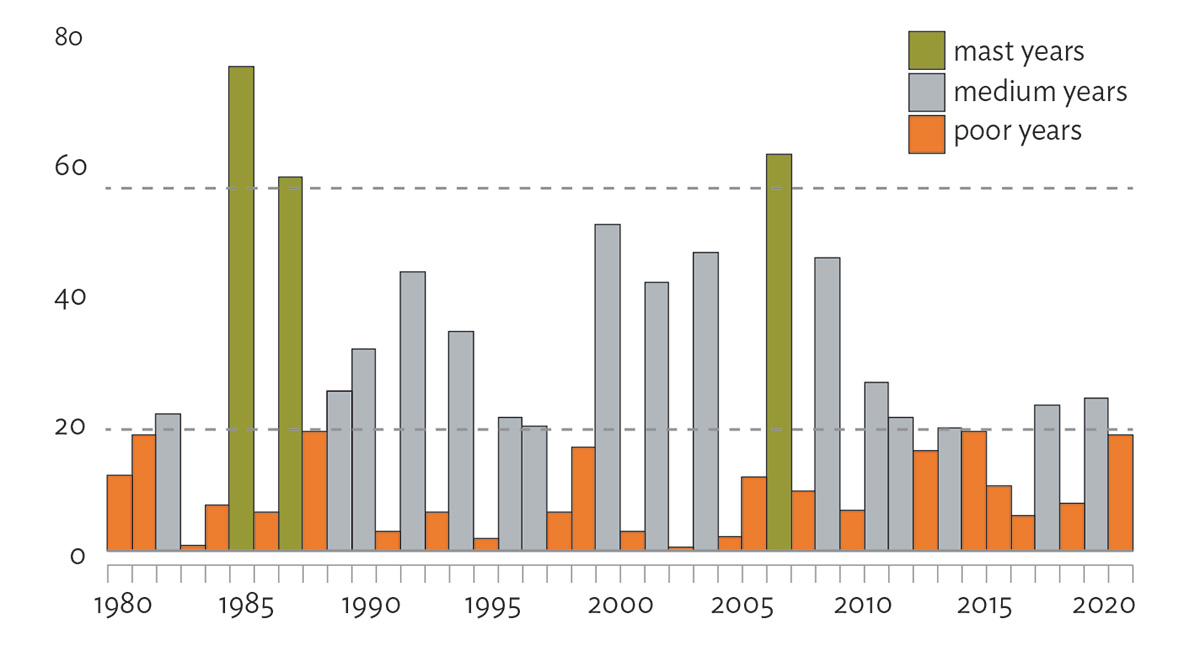

Exactly what weather conditions favor seed production varies between species and even, in some cases, among site locations. For everywhere we survey valley oak acorn production, the most important weather variable is mean maximum April temperature, at the end of the period when these deciduous trees leaf out and flower. Trees tend to produce larger acorn crops following warmer spring seasons. To the extent that warm spring temperatures are associated with relatively dry years, larger valley oak acorn crops generally follow dry winters.
Exactly how warm, dry April conditions prompt trees to invest in acorn production is not obvious. A hypothesis we’ve proposed, predicated on oaks being wind pollinated and the fact that a tree’s female flowers can’t be fertilized by its own pollen, suggests that when conditions are warm and dry, trees in the population flower more synchronously, have greater access to pollen from neighbors, have a larger proportion of their own flowers pollinated, and mature more acorns. This “phenological synchrony” hypothesis posits that weather conditions directly influence the physiology inside the trees, causing them to either invest more or invest less in reproduction. Given that when it’s a wet year in one part of California, it’s generally a wet year elsewhere in the state, a close relationship between weather and acorn production helps explain annual variability and synchrony.
So far we’ve kept the story simple by focusing on one oak species. There are, however, eight species of acorn-producing trees in the Bay Area (not including shrub and hybrid forms), at least five of which can grow in the same place. Each species is different, and as a result, all oak species do not necessarily mast synchronously. For example, acorns mature at different rates. Four of the eight Bay Area oak species—valley, blue oak, Oregon, and coast live—are “one-year” species that require a single year to mature acorns; that is, female flowers in the spring mature into acorns a few months later in autumn of the same year. Flowers of the other four—California black, interior live, canyon live, and tanbark—are “two-year” species whose flowers don’t mature into acorns until autumn the following year. As a result, weather conditions affect the pollination and fertilization of acorn production the same year in one-year species but affect acorn production the next year in two-year species. This timing difference virtually ensures that the acorn crops of one-year and two-year species are not synchronized with each other, in contrast to the synchrony we observe within a species.
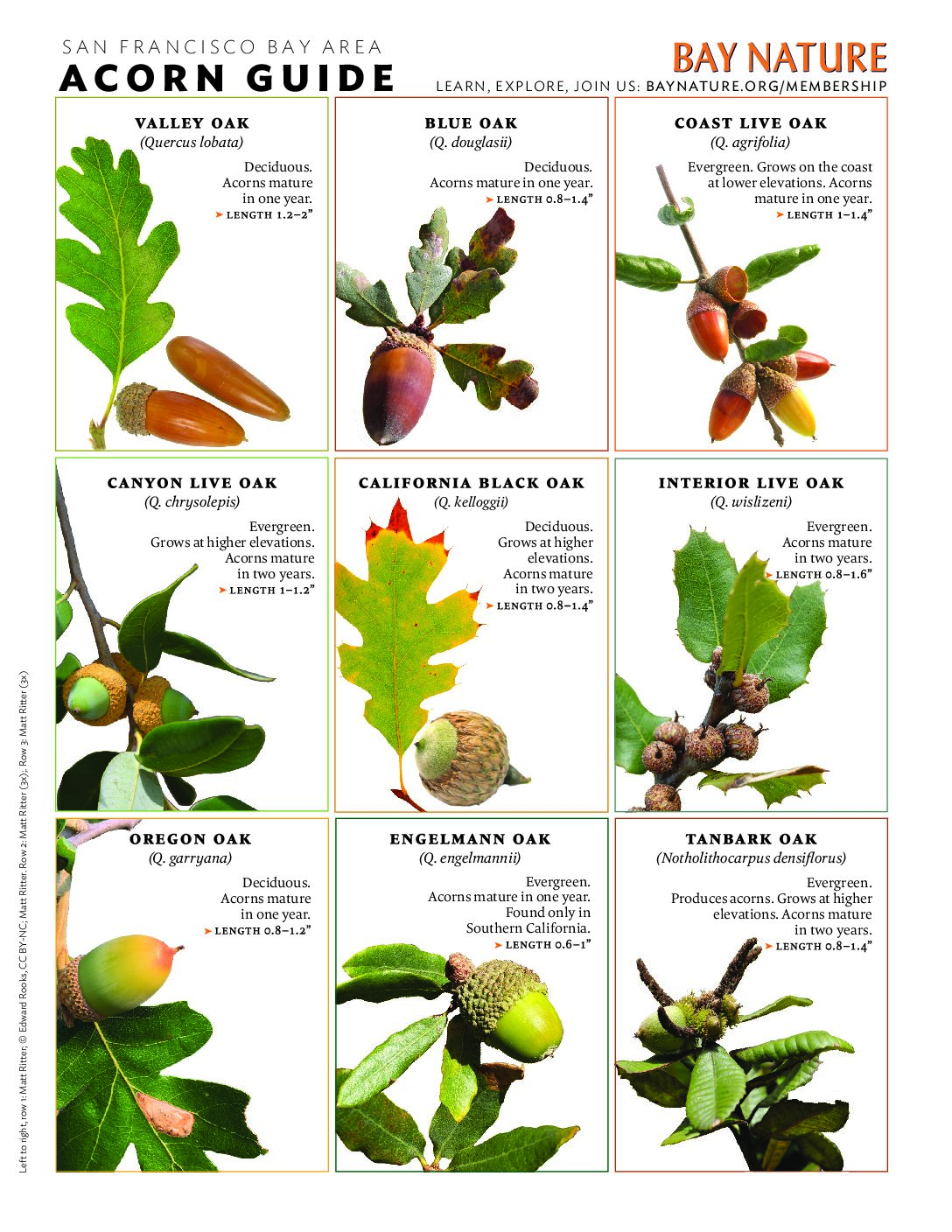
Because plant communities in California often include both one-year and two-year oak species, their asynchronous acorn crops have important ramifications for the animals that depend on acorns for food. Acorn woodpeckers, for example, are uncommon to rare in most California coastal sites where only a single species of oak—typically coast live oak—grows, but are common inland where several oak species live together. (Acorn woodpeckers are rare in Oakland and Berkeley, but common in Orinda and Lafayette.) When only a single species of oak grows in an area, crop failures are apparently too frequent for the birds to survive (note the frequency of poor acorn years in Figure 1). With more species of oaks, acorn woodpeckers do very well, since crop failures affecting all the oak species are rare, such as during that infamous fall of 1983 that forced so many of our acorn woodpeckers to abandon their territories at Hastings. Speaking of which, how did all those birds survive the winter and return the next spring, given the scale of spatial synchrony in acorn production by the oak species at Hastings? We suspect that they were able to spend the winter a few miles away on Chews Ridge, a high-elevation site where a species not present at Hastings—tanbark oak—produced a good crop of acorns.
Another complication is the striking variability among individual trees. We have mostly focused on the overall acorn crop at a particular location, but trees vary considerably in their overall acorn production even when growing next to each other. Some of this variability relates to the degree their root systems tap into the water table or other differences at a location, while some is genetic, affecting when the trees flower relative to other trees nearby. We have a much better understanding of overall acorn crop size year to year than we do of why acorn production among trees of the same species differs.
How will climate change affect oaks and masting behavior? To the extent that climate change alters regeneration and the geographic distribution of oaks, it will have significant effects on plant and animal communities throughout California. Effects of climate change on oak masting, however, are one of the many questions we don’t yet know the answer to. There is, however, evidence that changes have already taken place: a recent global analysis of masting based on data going back over 100 years found that seed production has become more variable from year to year and that overall productivity has dropped.
At this point you may be wondering what sort of acorn crop to expect this coming fall. It’s been a relatively dry winter and temperatures at Hastings during April were slightly warmer than, but still very close to, the long-term average. Similarly, the 2021 valley oak acorn crop was slightly smaller than, but still close to, the average crop size. So if I had to guess, I’d say it’s going to be an average year—neither a “mast” crop nor a bust. What I can assure you, though, is that however many acorns there may be in your yard, they don’t predict whether next winter will bring an end to California’s drought.


